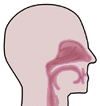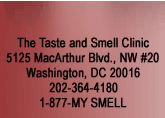  |
||
 |
May 2020How Does COVID-19 Infection Affect SmellMany patients who acquire COVID-19 infection develop both loss (hyposmia) and distortion (dysosmia) of smell function secondary to the infection. How does this occur? Smell function is comprised of a tripartite system involving brain, nerves, and olfactory receptors. Nasal mucus secreted from serous glands in the nasal cavity bathes peripheral portions of these tissues analogous to blood in systemic tissues. The main cause of smell dysfunction in over 25% of all smell loss (1) involves pathology of the nasal mucus which occurs following a viral infection as first described clinically in 1975 (2). In order to understand nasal mucus pathology and its relationship to smell dysfunction a biochemical analysis of this biological fluid was undertaken (3) and the biochemical components of this fluid were determined. Comparison of secretion of nasal mucus in normal subjects and patients following a viral illness revealed inhibition of secretion of several biochemical moieties in nasal mucus, called growth or transcription factors (4), including cAMP (5), cGMP (6), and some hedgehog (7) all of which were significantly impaired. These growth factors appear to be critical for the stimulation of olfactory receptor growth and development and without secretion of these growth factors olfactory receptors do not grow or develop with subsequent loss of smell (hyposmia) and eventually the development of smell distortions (dysosmia). The viral RNA associated with the systemic viremia interferes with the secretion of these growth factors from nasal serous glands with subsequent loss and distortion of smell. These losses are most commonly transient but in about 1-2% of these patients losses can be permanent with these symptoms persistent. Intranasal administration of phosphodiesterase inhibiters can activate secretion of these growth factors which can initiate regrowth of olfactory receptors with subsequent reactivation of normal smell function (8).
|
|